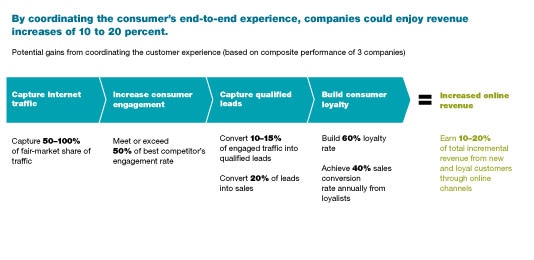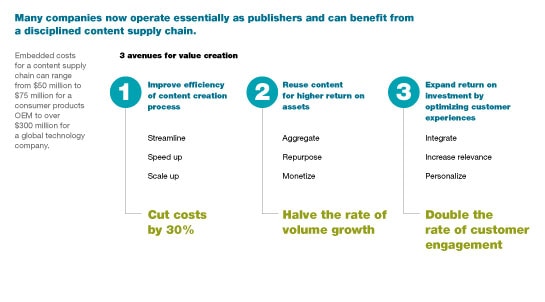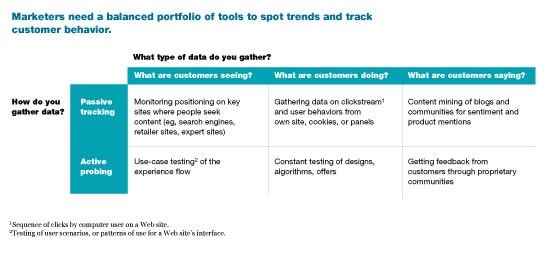Since the dawn of the Internet, marketers have regarded it as a vast laboratory, launching experiment after experiment to crack the code that generates sales and customer loyalty. Not surprising, most have failed. Consumers adopted digital technology as they themselves saw fit, in the process fundamentally altering the way they make purchasing decisions.1 Companies that understand this evolution are now carefully moving digital interactivity toward the center of their marketing strategies, rethinking their priorities and budgets, and substantially reshaping their processes and skills.
Through our work with dozens of companies navigating this shifting landscape, we have found that the most successful digital marketers focus on managing four core sources of value as they increase the percentage of marketing and channel spending that is directed to digital activities. First, they coordinate their activities to engage the consumer throughout an increasingly digital purchase journey. Second, they harness interest in their brands by syndicating content that empowers the consumer to build his or her own marketing identity and, in the process, to serve as a brand ambassador. Third, they recognize the need to think like a large-scale multimedia publisher as they manage a staggering increase in the content they create to support products, segments, channels, and promotions. Finally, these marketers strategically plot how to gather and use the plethora of digital data now available.
The digital-marketing difference
At the simplest level, we’ve always known that consumers tend to go through a multistage journey as they make purchasing decisions. Yet most companies still concentrate marketing resources on only two stages: brand marketing up front to woo consumers when they first consider products, and promotions at the final point of sale to sway them as they are about to make a purchase.
Digital technology is changing all that. Consumers who used to seek out family and friends for word-of-mouth product recommendations now read online reviews, compare features and prices on Web sites, and discuss options via social-networking sites. This information flow not only empowers consumers but also allows marketing departments to be part of the conversation consumers have as they actively learn about product categories and evaluate choices. In fact, both business-to-consumer (B2C) and business-to-business (B2B) purchasers increasingly want marketers to help them make smart decisions. They just don’t want to feel subjected to the hard sell—they expect marketers to engage them, not dictate to them.
Moving from a one-way, company-driven sales mentality to a two-way relationship with consumers requires core changes in the way marketers do business (see sidebar, “Digital marketing for the C-suite”). While some of them have adjusted effectively, most simply tried everything that came to mind, because they weren’t sure what would work. Companies have explored digital-marketing vehicles such as video ads, sponsored content, and online promotions. New forms of targeted online ad delivery have emerged. Web sites have been overhauled, and microsites for specific products or promotions have multiplied. Companies are buying thousands of search terms across their lines of business, and new agencies keep popping up to serve marketers’ increasingly keen desire for innovative content, user tools, or social experimentation. While these initiatives usually make sense, their implementation often doesn’t: most companies merely add them to their other operations and thus stretch their organizations financially and operationally. In our experience, companies must thoughtfully integrate such initiatives by focusing on four core sources of value.
Orchestrate an integrated consumer experience
Whether by receiving marketing e-mails, searching for products online, or using mobile devices to find retail coupons, customers today continually interact with brands as they move closer to making purchasing decisions. Yet completely different parts of an organization manage most such contacts. Digital channels can unify that experience and prevent the leakage of opportunity. Across a range of B2C and B2B clients, we’ve seen companies accelerate revenue growth by tightening the coordination of the end-to-end experience (Exhibit 1). These increases represent the cumulative impact of capturing more online traffic, engaging consumers effectively, raising sales conversion rates, and then deepening bonds with the brand after sales are made.
Coordinating the experience

To be sure, it’s not easy to coordinate content across the entire consumer experience, but the waste from failing to do so ought to be even harder to face. When done right, television commercials should at the very least inspire keywords for consumers to search. Great search positioning should offer easy-to-find Web links to specific offers being promoted in other media. Links should go deep into specific places to help consumers learn about and buy products. Retailer sites should show the same product with the same image, rich descriptions, and inventory availability. And all of these images and messages should be consistent.
Similar rigor is required to ensure that marketing investments are proportional to the influence they may have on a prospective customer’s purchasing decision. Consider the global consumer products company that traditionally relied on mass-media campaigns when launching new products. Because the brand was already well known, the campaigns failed to increase actual sales: the company was spending a disproportionate percentage of its marketing budget on advertising that consumers were largely ignoring.
The company realized that a big shift was needed—one that would likely ripple through much of its budgeting process, organizational structure, and agency lineup. It moved its spending to efforts toward influencing consumers as they actually evaluated products: by increasing its presence in stores and online, improving its search engine positioning, developing content for retailers’ Web sites, and cultivating recommendations from important online influencers, such as bloggers. Traditional media spending fell, and advertising agency budgets shifted toward online content development. As a result, the company doubled its rate of consideration as a top-three brand, almost tripled the rate of recommendations by salespeople in stores, and increased its market share.
Inspire customers to help you stretch your marketing budget
Traditional marketers spend about 60 percent of their budgets on “working media” (or paid placement), 20 percent on creating content, and the balance on employees and agencies. Digital channels, with their social nature, reverse these economics, focusing on a smaller core of engaged people who can spread positive impressions, or simply share information, with a broader audience. Active digital marketers tend to devote about 30 percent of their marketing budgets to paid media and 50 percent to content. Customers do more of the heavy lifting as they decide what to look at, play with content, and forward it to their online communities. We have found that by making the right investments, active digital marketers can spend significantly less on marketing as a percentage of sales, with little to no deterioration in performance.
Allowing consumers to make brands their own inevitably raises concerns among companies that are fearful of losing control over brands. The key is to strike a balance between retaining control and creating opportunities for consumers to embrace your content. One prominent example is American Express’s Members Project. Created to help consumers promote their favorite causes, the initiative offered $5 million to the nonprofit group that garnered the most vociferous support.
Consumer engagement was captured through a central Web site that offered tools for creating blogs about causes, widgets to distribute so that larger groups could show their affiliation, and a central system where members could rank causes. Despite very limited paid media (some banner ads, search, and e-mail), AmEx magnified its exposure through heavy interest from news sites and even traditional TV coverage. Celebrities became involved, placing widgets for their favorite causes on personal sites or Facebook pages. In short, this initiative generated an explosive viral campaign that made it one of AmEx’s most successful brand-building efforts, at little cost for paid media.
Adopt a publisher’s discipline to curb costs
Supporting the consumer’s decision journey requires a vast and growing range of content—well beyond advertisements. As companies chase digital opportunities, most have slowly but steadily begun publishing everything from static content, such as product descriptions, to games and other multimedia. Marketers are syndicating content and applications to flow across the sites and mobile platforms of other organizations and people. Content is increasingly being pulled on demand by consumers (who, for example, subscribe to alerts or become “fans” on Facebook) or is tailored to their preferences (determined through their past behavior), the context of an interaction, or the time of day. Most companies have now essentially become publishers, with a more complex set of cost and quality concerns, yet continue to behave like simple advertisers (Exhibit 2).
A disciplined content supply chain

Most marketers, failing to adopt the discipline of a multimedia publisher, don’t realize that deep within their operations, they are facing rapidly escalating production costs, unnecessary duplication, inconsistent quality of content, and second-rate interactions with customers. One global B2B software provider, for example, produced a growing amount of content—from advertising to cost-of-ownership analytic tools to sales support materials to instruction manuals—for each of its products in every geography, all tailored to different types of audiences and for different online placements. Obsolete content persisted across the Web. Much useful content was poorly tagged or not well linked to related content, making it hard for consumers to find. Product descriptions on the company’s own Web site, for instance, were often different from descriptions of the same products on a distributor’s site. Finally, budgets for content creation were buried across business units, and no one had a clear sense of how to pare down the amount of content or raise it to a consistent standard.
The software company’s solution was to adopt a comprehensive, portfolio-based view of its content with a view to streamlining production costs, making its content more reusable, and finding new ways to improve the experience that the content delivered. It dug into activities across the enterprise to calculate its total publishing costs and understand the spread of its multimedia publishing presence. Then it began rationalizing the system. New processes were implemented and a new organization created to coordinate, edit, and manage the content. Performance measures tracked how well the content drove sales. A central warehouse stored reusable core content objects, such as product descriptions. Salespeople and users received automatic notifications of product updates, tailored to their specific needs. Databases and analytics were created to better target the right content to the right consumers at the right time, so material was surgically placed to maximize impact.
Switching perspectives in this way—from that of a traditional advertiser to that of a tightly disciplined, personalized publisher—helped the company cut its operating costs by tens of millions of dollars a year. Its Web site generated dramatically more sales leads than it had before, by offering more timely, personalized, and useful content. The software company’s salespeople felt more confident about directing customers to use the Web for research and support during the buying process. By improving the customer experience, the new approach improved efficiency and raised returns on assets and on investment.
Use intelligence wisely to drive performance
When a prospective customer actively evaluates product options, the right message is needed immediately, in the right location. When online conversations start to trash your brand, no response can be fast enough. When you need to optimize your search and other media spending on ever-faster cycles—eventually daily—there’s no time to waste. One telecom provider, for example, manages more than 40,000 search terms, has developed dozens of algorithms to identify and reach relevant consumers, and has a war room to spot and react to online complaints or rumors. The ability to mobilize in that way requires smart investments in data tools, a group of skilled analysts, and flexible processes that can facilitate rapid action. What isn’t required is a multipage performance report, pondered at a meeting several days later, that substitutes for action.
Savvy digital marketers are mastering intelligence-gathering tools and processes that analyze what customers are seeing, by examining positions in search results or coverage on key retail sites. These marketers explain what consumers are doing, by analyzing their online behavior, and interpret what they are saying, by mining online discussions and soliciting ongoing feedback. Such intelligence, the lifeblood of digital leadership, disseminates insights throughout an organization to drive ongoing optimization and promotes the personalization needed to help consumers feel that a brand is their own (Exhibit 3).
The right mix

Marketers need the ability to assess and utilize intelligence in real time to drive performance by using it. Dell, for example, has a full-time team that monitors its IdeaStorm discussion boards and rapidly responds to posts. Packaged-goods companies are starting to manage thousands of search terms on a daily basis, not only optimizing what they spend but also looking for the keywords customers are using in association with their brands. One auto company tracks the volume of people using car configuration tools on its Web site as a way to forecast sales and tweak production. For these companies, such insights flow directly into operations. Unfortunately, that tight linkage between insight and action is rare.
We have found, for instance, that few marketing or sales executives can name three key insights, derived from their online analyses in the past month, that they acted upon to generate value. Activating a company’s intelligence goes beyond hiring statistical analysts, building dashboards, and writing reports. Marketers must prioritize what to measure, as well as assign a cross-functional team to analyze the data generated. Then they must have clear processes to act upon insights, track results, and follow up with action.
Taken together, these changes force companies to step back from tactical, day-to-day execution and take a more strategic view of where to invest and make changes. Companies often find that they must enhance their technology infrastructure, expand analytic skills, adjust organizational structures across business unit boundaries, and build processes that impose a new operational discipline. Tough decisions need to be made, such as who takes the lead in developing a new-product launch plan; how budgets for content creation are reallocated across global, regional, and local groups; and how to rebalance the roles of traditional media and digital agencies. Technology and marketing functions need to work together more closely, with clear service-level agreements from IT to maintain adequate support for much more information-intensive marketing operations.
Marketing departments will justifiably demand more resources, but those should come at a price: higher accountability for sales, innovation, and operational efficiency. Business line executives should demand better visibility into metrics about digital delivery and greater clarity about how marketing plans will directly improve performance. In return, marketers will drive value as their brands cease to be mere names and instead become central to helping customers get what they want.
Hitting the reset button on marketing begins by accepting a new perspective on what marketing needs to accomplish. It requires marketing executives to step up to a broader, cross-functional coordination role, armed with deep insights about the decision journey consumers are undertaking and the tools needed to guide it.

